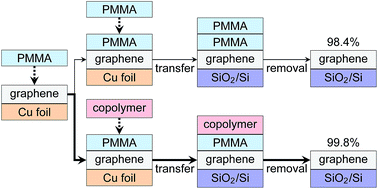Approaching completely continuous centimeter-scale graphene by copolymer-assisted transfer†
Abstract
Transferring graphene from copper foil to a target substrate should ideally be a nondestructive process, but cracks, holes, and wrinkles have proved difficult to prevent. Here we report a method in which we use a commercially available copolymer in addition to poly(methylmethacrylate) (PMMA) to obtain 99.8% continuous centimeter-scale transferred graphene. Our findings are based on characterization using Raman spectroscopy, quantitative image analysis, scanning electron microscopy, and terahertz time-domain spectroscopy. Compared to conventional methods, this copolymer-assisted approach not only results in fewer holes, but also effectively eliminates cracks and wrinkles. We attribute this to a more thorough relaxation of the initially deposited PMMA by solvent contained in the thicker copolymer layer. This results in improved contact at the PMMA–graphene interface before removal of the underlying copper substrate.



 Please wait while we load your content...
Please wait while we load your content...